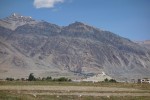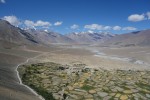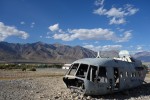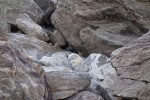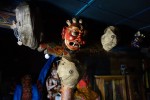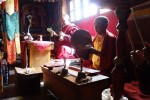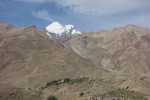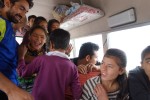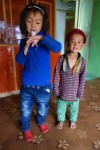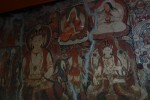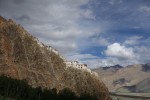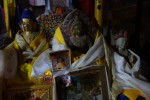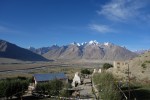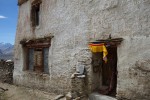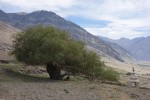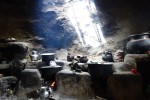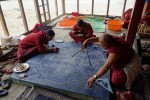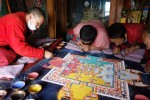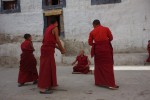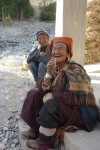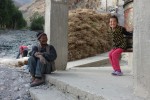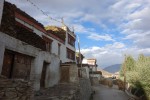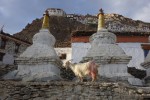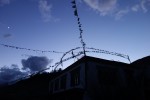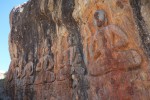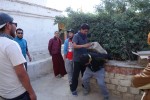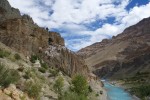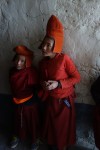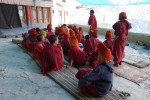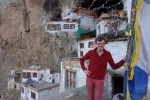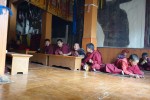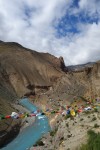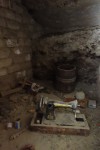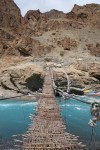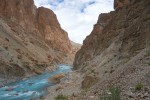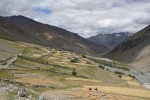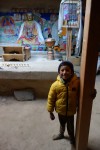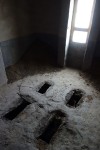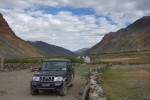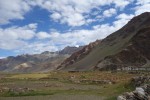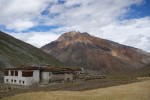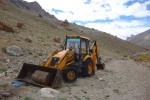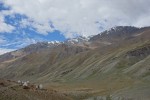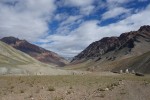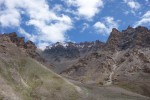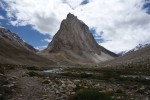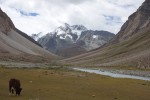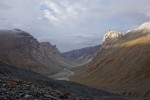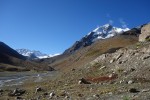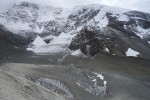I stayed in Czechia this whole summer (except for a few meters past the Polish and Slovak borders on some hikes: Polish blueberries are the best!). It was really enjoyable to take it easy, but it’s also time for some more stories from last year’s Himalayas, continuing this post.
The next plan was to go to Zanskar, a remote and not so often visited area, even for Ladakhi standards. I’ve been tempted to go to Zanskar also on my previous trips, but it never happened… For to get there, you either have to hike for a week, or suffer through 20 bumpy hours on bus and jeep. Some people do the drive on motorbikes… they at least pay for their engine fumes by having to swallow tons of dust (and then cough it out at night, sometimes together with some blood as bonus, as one of them told me). There are those who even go on a bicycle which sounds more intriguing to me! And also it’s hard to get decent food in Zanskar, that is, anything else than rice with dal, or fried noodles, or tsampa.
Since my plans for hiking there ended with the Kanji La fiasco, I had to backtrack and take the road. I was fairly lucky hitchhiking and by a combination of old car-bus-car-shared taxi got to Kargil on the same day I left the hike. Kargil is a curious Muslim town just next to the cease-fire line with Pakistan, but overall not the nicest place to visit. Anyway, to rest a little (and to check email!) and to arrange the onward jeep, I stayed there for two nights in a hotel that was decent two years ago… sadly not anymore, at least if you don’t enjoy bedbugs (and the resulting paranoia). Bug bites were overall quite interesting part of the whole trip – they aren’t that common in the mountains, but once I got some, they took over a week to heal and stop itching… and then I wasn’t sure if I was feeling new bites or the old ones, or if it was entirely my imagination. At least I didn’t bring any small friends with me back home in my sleeping bag!
So I was quite happy when the drive to Padum (240 km in 9 hours) was finally behind me and I was back among Buddhists. This is the center of Zanskar in a big triangular valley that is relatively fertile, and so is filled with villages and gompas (monasteries). I wrote more comments from my week there next to the photos below.
I wanted to continue from Zanskar south, so there was the big question of which pass to take. The most classical one, Shingo La, is quite touristy and already equipped with a dirt road for most of the way, so that’s not ideal for hiking. There are quite a lot of other passes, but some of them lead to southern Kashmir with serious danger from separatist insurgents. And others, such as Kang La, are quite hard, including maybe 10 kilometers long glacier – which I certainly wouldn’t risk doing on my own. It would be possible to get a guide for the trek, but it’s not exactly cheap. Also the weather was quite cloudy with some rain (which means snow higher up), so in the end I decided to take it safe and go via Shingo La. A little boring, but probably the right decision, as I later met a guy who couldn’t cross Kang La and had to return because of the snow fall.
So I started walking up the main valley, hoping to hitch a ride as far as possible to avoid the boring road. Again, I was quite successful – after a short ride on a construction truck, I got into a car with a father and his two sons, both under 10 years old. He was taking them to school for the new school year. To Manali, 200 km away as crow flies, but 1000 km by road! To avoid that, they drive south as far as they can, then walk across the Shingo La (in two days they cover what took me six, albeit leisurely, days) and take the bus to Manali where the kids stay on their own for the whole year while the father returns home. This is quite common in Zanskar and people even like to spread their chances for a good school: “One of our children is in school in Srinagar, one in Manali, another are in Jammu and Dehra Dun, …” (have a look on a map how far these cities are!)
I was slightly considering staying in the Anmu village and hiking up from there to the Cha mountain, which is 5960 meters high, but looks quite accessible from the maps, depending mostly on how tough it would be at the top with glacier and snow (I had no equipment for snow, nor a permit for the peak, so I most likely wouldn’t have gone all the way to the top anyway). But it was possible to drive further and I didn’t feel much like the climb, so I set the plan aside. It is always curious for me to compare my ideas from back home “oh, and there I can climb up this nice hill” with the reality in the mountains. Even when well acclimatized to the altitude, everything is still more tiring than at home… Together with the quite bad food one gets there, suddenly all extra walking becomes much less tempting. It is no accident that the only people crazy enough to go backpacking in the mountains without ponies are Czech and Polish!
When the road ended, the family hurried ahead and I walked a little more slowly in a light rain towards Phuktal. After maybe an hour I met a group of monks and then the family from the car, returning back to a bridge where they needed to cross to the other bank of the river… I felt really sorry for the kids in the rain, although they looked brave enough for now.
Phuktal! The famous monastery built around a big cave, even nowadays quite hard to get to. Phuktal was one of the main motivations for me to go to Zanskar. And, as these things often are, a big disappointment when I got there. The gompa itself is pretty, but the monks seem to be more focused on money from tourists than on anything else. Standards vary quite a lot between monasteries in Ladakh, and it is also certainly a matter of luck whom one meets in a given monastery. Strictly speaking, Buddhist monks take oaths not to use money at all, although this is not practised in Tibetan Buddhism (contrary to, say, southern Theravada tradition). Anyway, temples should be open to everyone for free, although it is expected to make a reasonable donation when visiting. Locals do this always, but tourists often don’t, which led some monasteries to institute entrance fees. Certainly not ideal, but still quite understandable to me. Sadly, Phuktal took this to higher level with monks assertively asking for “donations”=tips, etc. So I was quite happy to leave the next morning.
Followed a series of homestays, friendly in Purne and Kargyak, and not so good in Tangtse. And a “tea tent” at Lakang for the last night before the pass.. filled with smoke, horsemen and fathers who were returning after dropping their children to school. And then the easy Shingo La pass at 5000 meters from which a road goes down south to Lahaul and Keylong. I was quite lucky again that I caught a ride down in the last of the two or three cars that went there that day!
After writing this, I feel a little strange that maybe I’m focusing too much on the bad stories. But the nice and good stuff is so common that it feels not so interesting to write about… All the friendly people, both locals and tourists, atmospheric monasteries, impressive beautiful mountains: just look at the pictures, what more can I add?
- Padum valley with Karsha gompa in the distance
- Looking from Stongde
- Padum landmark: broken army helicopter
- Folk dances
- Fox!
- Hitchhiking on a bus full of singing kids on a school trip. They took me for such an expert that I was even helping with the directions to get to Karsha.
- Children in my homestay in Karsha
- Old monastery paintings are typically much more soft and beautiful than the new ones.
- In Karsha monastery
- Here I was, exactly a year ago
- This small gompa is indeed very well guarded against attacking evil spirits
- Monastery kitchen
- Geometry preparations for a mandala
- Student monks practicing the art of buddhist debate
- Preparing winter supplies
- Ancient Buddha carvings (maybe from 8th century), sadly “restored” with cement
- It certainly brings you very good karma to carry this ancient stone around the courtyard
- Phuktal, monastery in a cave
- Young monks having fun at a puja, prayer ceremony
- What would a monastery be without an old sewing machine?!
- Harvest time
- My guide to the small Tangtse gompa.
- A quadruple latrine! Latrines in Ladakh are very hygienic and do not stink, but still I can’t imagine four people squatting there at the same time.
- Undreamt-of jeep in the middle of mountains
- Baby yak
- Šikula! (handy guy in Czech)
- Gumburanjon mountain
- Yaks fighting
- At the top of Shingo La
